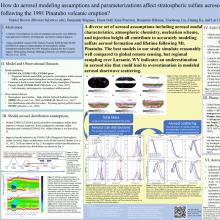How aerosol modeling assumptions and parameterizations can affect stratospheric sulfate aerosol following the 1991 Pinatubo volcanic eruption
Hunter
Brown
University of Wyoming
Poster
The 1991 Pinatubo eruption remains the largest volcanic eruption observed during the satellite era, injecting 18-19 Tg of sulfur dioxide (SO2) into the stratosphere. Just over half of this SO2 oxidized to form long-lived (3-4 years) sulfate aerosol, which scattered incoming solar radiation and absorbed outgoing longwave radiation, significantly impacting atmospheric temperature by altering the global radiative balance. Pinatubo provides an important validation for the simulation of stratospheric sulfate in earth system models given the relatively high availability of remote sensing and in-situ data before and after the eruption. This validation helps identify how well aerosol parameterization in these models are simulating the sulfate lifecycle, including emission, formation, lifetime, and climate impact. Here we use remote sensing and in-situ balloon measurements from Laramie, WY to validate version 2 of the Energy Exascale Earth System Model (E3SMv2) with improvements to its stratospheric sulfate representation. By comparing E3SMv2 to a very similar model with more advanced atmospheric chemistry, CESM2-WACCM6 (the Community Earth System Model (CESM2) with the Whole Atmosphere Community Climate Model version 6 (WACCM6)), some of the side effects to a simpler chemical treatment within E3SMv2 are identified. Both E3SMv2 and CESM2-WACCM simulate stratospheric sulfate aerosol that is smaller than in observations; potential reasons for this difference and its implications on simulations of global radiative balance are explored.

Brown-Hunter-poster.pdf
(2.98 MB)
Meeting homepage
